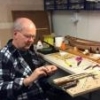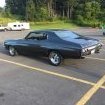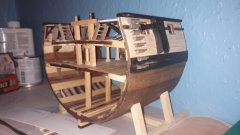-
Posts
314 -
Joined
-
Last visited
Reputation Activity
-
 Moxis got a reaction from ccoyle in Le Cerf by Moxis - FINISHED - 1/48 scale - French cutter
Moxis got a reaction from ccoyle in Le Cerf by Moxis - FINISHED - 1/48 scale - French cutter
Earlier here was a folder for finished scratch built projects. This does not exist any more, so this is why I have to introduce my completed project at this folder. I am sorry that I didn`t issue any building blog about my project, but in the beginning I was not sure at all, if I ever will finish this project.
So, during about two years I have been building a model of French cutter Le Cerf, and finally a few days ago it could be regarded as finished. When searching a new project to build, from the beginning I somehow liked the one mast cutter Le Cerf, issued by French Ancre. So I purchased the documentation package, which included much information about French Navy in general, and especially about the vessel itself. Included were also 12 sheets of plans, which were drawn in the scale of 1/48, which suited me very well, because my previous build was also made at this scale.
After having studied the documents and plans for a couple of days, I started the project by making the bulkheads out of plywood. Hull & deck planking were made using strips sawn of abachi wood, which was a positive surprise for me, because it was very easy to work with and to bend the strips and attach them in place. The hulls of French cutters were made in clinker method, and after first difficulties it seemed to me easier to make than "normal" smooth hulls.
Gun carriages and othe small details were made of cherry wood, and decorations at the stern were carved of boxwood.
Gun barrels are made of brass, together with the blocks and rigging threads they were the only purchased parts. Sails were made of thin Egyptian cotton. It was colored with acrylic paints together with a small amount of white glue diluted in water.
I am quite happy with the result. Now again I am in the situation of trying to decide what to build next.
-
 Moxis got a reaction from smtm2013 in How to fix copper/brass strips and fittings to hull or other surfaces?
Moxis got a reaction from smtm2013 in How to fix copper/brass strips and fittings to hull or other surfaces?
I have also found out that the 5 minutes Araldit does not always cure completely hard. That is why I have moved to use the 60 minutes Araldite which seems to work better.
-
 Moxis got a reaction from DaveBaxt in Proxxon Mini Lathe DB-250 - Opinions/assessments/recommendations?
Moxis got a reaction from DaveBaxt in Proxxon Mini Lathe DB-250 - Opinions/assessments/recommendations?
I have sometimes used the Proxxon drill chuck with a Proxxon arbor in a bigger lathe to turn very small parts which are not possible to attach in a big lathe 3 jaw chuck. The first picture is showing this:
The second picture shows the size difference of Proxxon 3 jaw chuck and drill chuck on the bed of DB250 lathe together with lathe spindle thread. From this picture it is easy to see that the drill chuch does not fit on the lathe spindle thread:
-
 Moxis got a reaction from Rudolf in 19th Century French portable binnacle
Moxis got a reaction from Rudolf in 19th Century French portable binnacle
When I was making a round compass cowl for my Maaninka steamer, I first made a suitable sized ovalish ball out of plasticine. On the ball I applied a thin coat of a gel of milled fiberglass and epoxy, but left the underside open. When the epoxy was cured I removed the plasticine so I had a thin ballform coating which was sanded smooth and painted with brass colored Alclad. When weathered with black pigments the result looked quite realistic, although was not shiny polished unit as normal with these things. Thin celluloid plate was glued inside the cowl as a glass and nice compass rose found in Internet was scaled and printed & attached under glass. Then the cowl was glued on top of a wooden pinnacle.
-
 Moxis got a reaction from Egilman in 3d printing crew figures
Moxis got a reaction from Egilman in 3d printing crew figures
This is exactly what I would like to do too. The quality of prints made with resin printers is way better than ones produced with machines using filaments. Also the cost of these printers begins to be acceptable.
But what is still prohibiting me to step on this path is the problem to learn to use a 3D design software so brilliantly that I could be able to produce something that I could be happy with.
I have a hobbyist's free version of Fusion 360 software which I have tried to learn, but still after a few month's practize I am still far from being able to design parts for ship models I would like to print.
So my question is, which software you guys are using to design your parts or crew members, and how have you learned to use it properly so that the quality of prints is acceptable?
-
 Moxis got a reaction from nehemiah in My humble method of making strops for blocks
Moxis got a reaction from nehemiah in My humble method of making strops for blocks
There has been recently many methods shown to make strops around small blocks. When rigging the guns for my Le Cerf I needed a big number of small 3 mm double blocks. For making strops around these I made this simple fixture, which fullfilled it`s task quite reasonably.
First a simple construction was made of a piece of scrap wood and 2 mm plywood. Small pieces of 1 mm and 0,6 mm iron wire were glued into the bottom of the jig, and grooves were sawn with jeweler`s saw into the plywood walls:
Pieces of 0,15 mm thread were put into the first grooves, and blocks were positioned to the jig so that the 0,6 mm wire was put through one hole of the block:
Then small pieces of 0,6 mm rigging thread were placed into the second grooves:
And then it was rotated around the block and then around the 1 mm iron wire:
And now it remained only to make a small knot between the block and the 1 mm loop using the thinner thread, and attach small blops of diluted PVA glue into both ends of the block. After the glue had dried, ends of threads were cut as near as possible of the block.....
..... and blocks were ready......
......and used for rigging the guns:
-
 Moxis got a reaction from Gabek in 3d printing crew figures
Moxis got a reaction from Gabek in 3d printing crew figures
This is exactly what I would like to do too. The quality of prints made with resin printers is way better than ones produced with machines using filaments. Also the cost of these printers begins to be acceptable.
But what is still prohibiting me to step on this path is the problem to learn to use a 3D design software so brilliantly that I could be able to produce something that I could be happy with.
I have a hobbyist's free version of Fusion 360 software which I have tried to learn, but still after a few month's practize I am still far from being able to design parts for ship models I would like to print.
So my question is, which software you guys are using to design your parts or crew members, and how have you learned to use it properly so that the quality of prints is acceptable?
-
 Moxis got a reaction from thibaultron in 3d printing crew figures
Moxis got a reaction from thibaultron in 3d printing crew figures
This is exactly what I would like to do too. The quality of prints made with resin printers is way better than ones produced with machines using filaments. Also the cost of these printers begins to be acceptable.
But what is still prohibiting me to step on this path is the problem to learn to use a 3D design software so brilliantly that I could be able to produce something that I could be happy with.
I have a hobbyist's free version of Fusion 360 software which I have tried to learn, but still after a few month's practize I am still far from being able to design parts for ship models I would like to print.
So my question is, which software you guys are using to design your parts or crew members, and how have you learned to use it properly so that the quality of prints is acceptable?
-
 Moxis got a reaction from thibaultron in Laserboard, what material and where to get?
Moxis got a reaction from thibaultron in Laserboard, what material and where to get?
I found also the company Automated Artists, and have placed my order for certain thicknesses of Polybak for testing. Even when Chuck told us that this material is too weak for routing, I would like to try that. When producing very tiny parts, they must not be very strong to fullfill their purpose, which is only to emulate small metal parts. And when machined with 0,3 mm router bit very carefully I am almost sure that I can manage that work.
However being material which is very hard to find and transport from US to Europe especially in small quantities, it would be nice to find some equivalents nearer. So this "Hartpapier" or Bakelite, as we also know it here, would also be very interesting material to know better and worth testing how it would suit for the purposes of model ship building.
-
 Moxis got a reaction from thibaultron in Laserboard, what material and where to get?
Moxis got a reaction from thibaultron in Laserboard, what material and where to get?
Thanks Chuck for your message. I also have tried to find this material everywhere, because it would suit perfectly also for cutting with cnc router (I think).
I have tried to find a substitute for photo etched parts which could be produced with a router, by trying different plastics, but without success. The best material so far has been thin aircraft plywood, or a product called Sikablock, but it is very difficult to cut slices thin enough (<0,5 mm) of this material. So laserboard would be the perfect answer for my needs, but I cannot understand why it is so difficult to get. Maybe I have to try your link, but I doubt they will not sell it for private persons, especially when they are situated on the other side of the globe.
But I wonder where the railroaders are getting their stuff?
-
 Moxis got a reaction from thibaultron in Laserboard, what material and where to get?
Moxis got a reaction from thibaultron in Laserboard, what material and where to get?
Thanks amateur, just that. I have to place my order immediately. The only thing is that I thought it to be thinner. But this is a good start.
-
 Moxis got a reaction from thibaultron in Laserboard, what material and where to get?
Moxis got a reaction from thibaultron in Laserboard, what material and where to get?
After having read Chuck's wonderful build log about the cutter Cheerful, I came to the page where he describes having made certain parts of laserboard. This material seems to be outstanding when producing tiny parts either with laser or maybe also router. But where to get this material and which thicknesses are available? After a short googling it seems that nobody knows this material, especially in Europe.
-
 Moxis got a reaction from mtaylor in 3d printing crew figures
Moxis got a reaction from mtaylor in 3d printing crew figures
This is exactly what I would like to do too. The quality of prints made with resin printers is way better than ones produced with machines using filaments. Also the cost of these printers begins to be acceptable.
But what is still prohibiting me to step on this path is the problem to learn to use a 3D design software so brilliantly that I could be able to produce something that I could be happy with.
I have a hobbyist's free version of Fusion 360 software which I have tried to learn, but still after a few month's practize I am still far from being able to design parts for ship models I would like to print.
So my question is, which software you guys are using to design your parts or crew members, and how have you learned to use it properly so that the quality of prints is acceptable?
-
 Moxis reacted to highlanderburial in 3d printing crew figures
Moxis reacted to highlanderburial in 3d printing crew figures
The biggest factor for 3d printing figures is the starting digital model (high res or low res) and how fine the printer can print per line. My printer can do lines down to .01 microns (1/10th a human hair roughly) so it can make them pretty fine. To succinctly answer your scale question there are presently 1/350th scale sailors for sail as a low res digital file. For that size it is probably more than adequate for a viewer to see guys with covers arms and legs in various poses that look the part. My biggest concern would be getting something this small off the print bed which usually involves a small flat head screw driver. I am learning to print with supports that make this process less damaging but it is still a learning curve. I would easily think a figure designed for 1/48 could be scaled down to 1/100 with a pretty fair amount of details retained. In the picture is one of my print failures (due to file corruption on the leg). In the picture I printed a female Archer at 1/24th scale, 1/35, 1/52, 1/48. Not pictured was the Archer in 1/87 and 1/96. These were all done using the same file and at the same time. At 1/96 the bow was VERY thin but most of the details translated well. Keep in mind I got this printer with resin for around 275 dollars American. It is NOT the too if the line but will easily do what I need it to. I hope this helps!
-
 Moxis reacted to HSM in 3d printing crew figures
Moxis reacted to HSM in 3d printing crew figures
I recently bought the same printer you have and have used it to make davits and lifeboats for a cruise liner I am making. It produces amazing results doesn't it? Being a newcomer to 3-D modeling I am impressed with your figures. Can you briefly tell how you made the computer models?
-
 Moxis reacted to MEDDO in 3d printing crew figures
Moxis reacted to MEDDO in 3d printing crew figures
Those look really nice especially if you were able to whip em up over the weekend. Properly scaled figures always add life to a static model and really help with visualizing the scale of the project
-
 Moxis reacted to mtaylor in 3d printing crew figures
Moxis reacted to mtaylor in 3d printing crew figures
Your figures came out very well. Use of a 3D printer shouldn't get you any flack. I used the search feature at the top of page (make sure to change the setting to "this forum" and used "figures". Quite a few hits actually and I'm pretty sure there's more in other sub-forums.
-
 Moxis reacted to highlanderburial in 3d printing crew figures
Moxis reacted to highlanderburial in 3d printing crew figures
Greetings all,
While I am pretty sure posting anything made from a 3d printer is probably bad form here I wanted to share a side project I worked on over the weekend. I personally love seeing crew figures on model boat/ships but always have a hard time finding them in the scales or poses I want. This weekend I digitally drew out 4 "age of sail" style crew in 4 poses in my 3d aoftware. I then printed them in 1/48 ish scale. The awesome part about having these designs is I can size them up to 40mm or down to 3mm tall. I think they would look at home on a pirate ship or navy vessel depending on how they get painted. In the second photo I have compared my prints to an Amati figure (right) and a 1/48 scale figure on the left. The figure with the saber was literally transposed from a Captain Morgan rum ad! The UV light is used to cure the resin.
Has anyone else done this?
-
 Moxis got a reaction from Canute in Ripping Planks - what I've learned from others
Moxis got a reaction from Canute in Ripping Planks - what I've learned from others
Usually I scratch build models of 45...47" of length, therefore needing planks of 50" to be able to use one plank from bow to stern.
-
 Moxis got a reaction from Canute in Ripping Planks - what I've learned from others
Moxis got a reaction from Canute in Ripping Planks - what I've learned from others
Quite often I am cutting planks of 50" length or more with my Proxxon, and have no problems at all to do that. I am supporting the stock sideways against fence with a block of wood as described here, and with another hand pushing the stock through. My blade is a Proxxon one with carbide tipped teeth and 1,6 mm kerf. After a little practice everything goes quite smoothly.
-
 Moxis got a reaction from mtaylor in Ripping Planks - what I've learned from others
Moxis got a reaction from mtaylor in Ripping Planks - what I've learned from others
Usually I scratch build models of 45...47" of length, therefore needing planks of 50" to be able to use one plank from bow to stern.
-
 Moxis got a reaction from mtaylor in Ripping Planks - what I've learned from others
Moxis got a reaction from mtaylor in Ripping Planks - what I've learned from others
Quite often I am cutting planks of 50" length or more with my Proxxon, and have no problems at all to do that. I am supporting the stock sideways against fence with a block of wood as described here, and with another hand pushing the stock through. My blade is a Proxxon one with carbide tipped teeth and 1,6 mm kerf. After a little practice everything goes quite smoothly.
-
 Moxis got a reaction from Duanelaker in Simple carving techniques for first-timers using a rotary tool and burrs
Moxis got a reaction from Duanelaker in Simple carving techniques for first-timers using a rotary tool and burrs
This is my first attempt with carving. As I said earlier, my new project needs some simple carvings at the stern. After having read all tutorials available, I chose to use rotating tools for this work, because it feels easier for me than to use knives and chisels and the quality of carvings might be better, at least for me with no previous experience.
So the first thing was to obtain suitable wood for this work. Having read from different sources that boxwood would be the best choice, I started to look for that. Soon I found out that this kind of wood couldn`t be found anywhere in this country. So I ordered a lump of good looking boxwood fron the supplier in the UK.
Next I thought to start from the most difficult thing, the letters for ship`s name. These are very small, about 3,5 mm high, and preferable made with old type font. Laser cutting was first tried with fonts found in Corel Draw. They were scaled and sent to laser cutting company, but results were not at all acceptable. It was not possible to have these small letters not to be burnt by the laser, and removing the unevitable char from them would have been almost impossible. So next I turned into my dear old cnc router, and after some testing and changes the results were improving until acceptable. Letters are cut from 0,6 mm thick boxwood, letter height is 3,6 mm and they were cut with dia. 0,3 mm cutter. The font was found from the CADCAM program`s (Vector) font library.
A nice picture of red deer was found in Internet, scaled down with Corel Draw and printed on paper. This was glued on 2 mm boxwood and cut with a jeweler`s saw, and edges rounded with the rotary tool, using old dentist`s cutting bits.
The remaining parts were also cut of 2 mm boxwood and "machined" with rotary tool.
Finally all parts were glued into the stern of the model and stained with light walnut color.
-
 Moxis got a reaction from Edwardkenway in Casting of cannon barrels of polyurethane resin
Moxis got a reaction from Edwardkenway in Casting of cannon barrels of polyurethane resin
First I decided not to issue this at all, but after having seen here elsewhere Chuck`s tutorial about casting the thin carvings out of PU, I decided to publish also my method to cast cannon barrels. I have used this method many times before when building my car & tank models, so I had a little experience about the chemicals and working methods also before starting to cast cannons.
The first thing was naturally to turn a pattern for the barrel in the lathe:
Next thing to do is to make a spruce, a channel through which the liquid resin is poured into the mold. For this a piece of 3 mm iron wire was used:
And then we can start making the mold. First a small box was made of 3 mm MDF. The pattern together with spruce was installed into one of the walls of this box, approximately at half height of the short wall. Then liquid silicone rubber was poured into the box so that the level is at the middle of the barrel. Sorry that there is no picture of this phase.
I was using Oomoo 25 silicone rubber, made by Smooth-On. It consists of two parts A and B, small amount of each is measured into a small container, mixed thoroughly and poured into the box. When cured, releasing agent was applied to the lower part of the mold and new batch of silicone rubber was made and poured to the box and let cure.
This is how the first half of a mold looks like, when dismantled from the box. The pattern with spruce is still on its place:
And here you can see the both halves of the mold. A cone is provided at the top of mold where resin is poured. Small air venting channels are also cut at the top of the barrel to have air to escape when resin is poured into mold:
The mold is closed and polyurethane resin is prepared by using equal amounts of part A and B of the Smooth Cast 305 resin from the same manufacturer as the rubber. Parts are stirred very carefully and poured into the cone of the mold. It would have been possible at this phase to add some metal powder to the resin, to have the barrel really look like cast out of metal. I have however found out that if metal powder is added into the resin, it will become very stiff and doesn`t flow very easily into the spruce & fill the barrel cavern completely.
Resin has been poured and it can be seen that it has raised into the air venting channels too, which proves that the barrel cavern is filled as well:
After the resin has cured and mold opened, the spruce and barrel look like this:
Now it remains only to clean the barrel, drill holes for the axle pin, ignition powder and naturally for the cannonball, and glue a small glass pearl into the back of the barrel:
And finally paint the barrels. I wanted them to look like old patinated bronze, so I mixed Model Master gloss black enamel paint with AK Interactive`s old bronze metal color. Diluted them so that the paint could be airbrushed on the barrels. And finally, when dry the barrels were wiped lightly with a soft cloth to get the look of old patinated bronze:
-
 Moxis got a reaction from mtaylor in Lower cost (?) shiny metal parts
Moxis got a reaction from mtaylor in Lower cost (?) shiny metal parts
Very interesting. It begins to be clear that you can electroform or electroplate items relatively easily at home with copper, but us ship model builders would need parts made of, or at least look like made of brass. So I think it is not possible to apply brass surface directly on conductive paint, but you need first to electroplate the part with copper.
But how about gold plating, can it be applied directly on conductive paint? Gold plating could be perfect on small items, it will look like polished brass, never oxidize and very thin layer of gold doesn't cost very much more than plating the parts first with copper and after that with brass.











